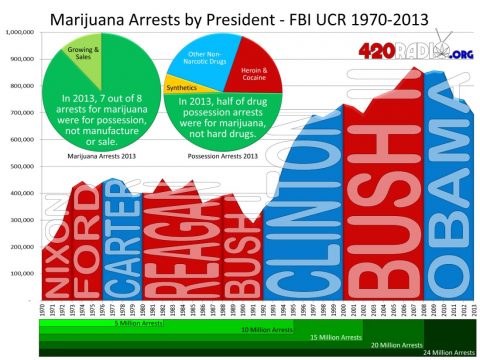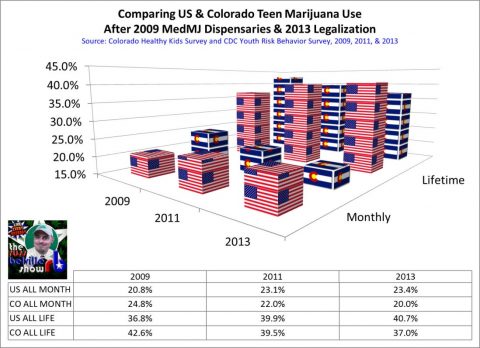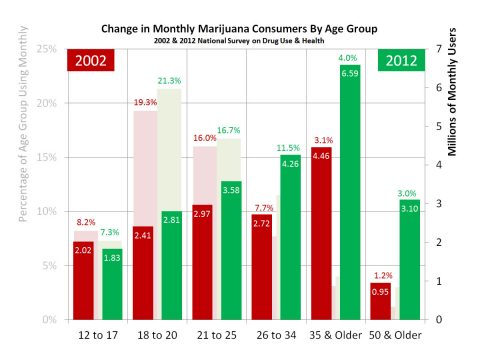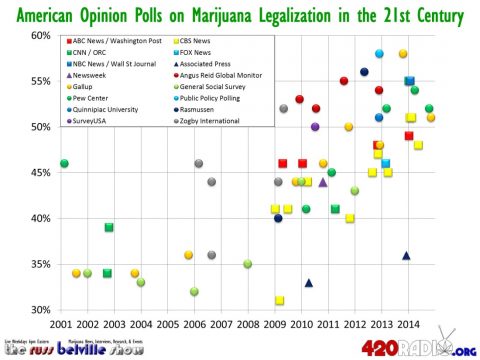The Top Five Marijuana Data Points of 2014
2014 may be looked back on as the year momentum for nationwide legalization of marijuana hit the tipping point. Aside from marijuana becoming legalized in two more states, here are five sets of data that seem to confirm that inevitability:
National marijuana arrests decreased for the fourth year in a row. Not only is it the first time arrests have dropped four years in a row, the total of 693,482 national marijuana arrests in 2013 is the lowest total in fifteen years. During Barack Obama’s presidency, there has been an overall 18 percent decline in the annual marijuana arrest total. The #1 and #4 greatest one-year declines in annual marijuana arrests have occurred on Obama’s watch.

Teen marijuana use in Colorado has dropped in the two successive surveys. In the 2009, the year Colorado’s dispensary system began to flourish, the Colorado Healthy Kids Survey said 24.8 percent of teens said they used marijuana monthly. In 2011, that figure was down to 22 percent and by 2013, after a year of legalization, the figure is down to 20 percent.

Teenage marijuana use is falling while senior use has tripled. According to the National Survey on Drug Use and Health, in 2002 there were 3.9 million teenagers (age 12-17) using marijuana annually. In 2012, that had dropped to 3.4 million. Over that same decade, use by seniors (age 50+) increased from 1.6 million to 4.7 million. This isn’t just due to the Baby Boomer demographic bubble that’s aging every statistic, however. That teen annual rate dropped from 15.8 percent to 13.5 percent while the senior rate increased from 2.1 percent to 4.6 percent. Among monthly marijuana consumers, teens dropped from 2 million to 1.8 million and their rate dropped from 8.2 percent to 7.3 percent, while seniors increased from less than 1 million to 3.1 million with a rate increase from 1.2 percent to 3 percent. That’s right, while the senior annual use rate doubled, the senior monthly use rate tripled!

There is no longer majority support among any demographic for jailing pot smokers and the overall majority favors legalization. By age, race, and politics, there is solid support for the idea of decriminalization – that possession of small amounts of marijuana for personal use should not be subject to jail time. According to Pew Research Center’s report, “America’s New Drug Policy Landscape,” more than three out of four (76 percent) believe in no jail for pot, with Republicans (69 percent), 65 and older (63 percent), and Hispanics (60 percent) offering the least support for decriminalization. Over four in five (81 percent) of those aged 18-29 and, surprisingly, aged 50-64, support decrim. Meanwhile, there were nine polls asking about legalization support in 2014 and only one came up below 50 percent, a 48 percent plurality support for legalization vs. 47 percent opposed, with a poll average of 52 percent support.

Not only do Americans believe marijuana is safer than alcohol… they think it’s safer than sugar! According to a Wall Street Journal poll, Americans find marijuana less harmful than sugar. Given a choice of four popular substances, tobacco was listed by almost half the respondents (49 percent) as the most harmful, followed by alcohol in second place with 24 percent, and sugar in third with 15 percent. Marijuana was considered the least harmful, with just 8 percent of respondents ranking it the most harmful substance. And speaking of sugar, three studies now have shown marijuana consumers have less risk for diabetes and lower body-mass-index and prevalence of obesity than non-tokers.







